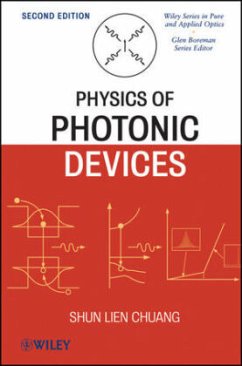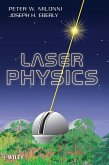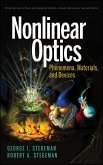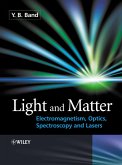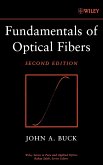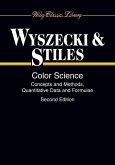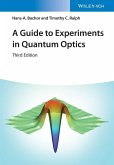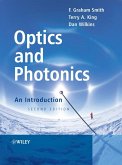Shun L. Chuang
Physics of Photonic Devices
Shun L. Chuang
Physics of Photonic Devices
- Gebundenes Buch
- Merkliste
- Auf die Merkliste
- Bewerten Bewerten
- Teilen
- Produkt teilen
- Produkterinnerung
- Produkterinnerung
The most up to date book available on the physics of photonic devices This new edition of Physics of Photonic Devices incorporates significant advancements in the field of photonics that have occurred since publication of the first edition (Physics of Optoelectronic Devices). New topics covered include a brief history of the invention of semiconductor lasers, the Lorentz dipole method and metal plasmas, matrix optics, surface plasma waveguides, optical ring resonators, integrated electroabsorption modulator lasers, and solar cells. It also introduces exciting new fields of research such as:…mehr
Andere Kunden interessierten sich auch für
![Laser Physics Laser Physics]() Peter W MilonniLaser Physics190,99 €
Peter W MilonniLaser Physics190,99 €![Nonlinear Optics Nonlinear Optics]() George I. StegemanNonlinear Optics114,99 €
George I. StegemanNonlinear Optics114,99 €![Light and Matter Light and Matter]() Yehuda BandLight and Matter66,99 €
Yehuda BandLight and Matter66,99 €![Fundamentals of Optical Fibers Fundamentals of Optical Fibers]() John A. BuckFundamentals of Optical Fibers167,99 €
John A. BuckFundamentals of Optical Fibers167,99 €![Color Science Color Science]() Günther WyszeckiColor Science136,99 €
Günther WyszeckiColor Science136,99 €![A Guide to Experiments in Quantum Optics A Guide to Experiments in Quantum Optics]() Hans-A. BachorA Guide to Experiments in Quantum Optics89,99 €
Hans-A. BachorA Guide to Experiments in Quantum Optics89,99 €![Optics and Photonics Optics and Photonics]() F Graham SmithOptics and Photonics244,99 €
F Graham SmithOptics and Photonics244,99 €-
-
-
The most up to date book available on the physics of photonic devices This new edition of Physics of Photonic Devices incorporates significant advancements in the field of photonics that have occurred since publication of the first edition (Physics of Optoelectronic Devices). New topics covered include a brief history of the invention of semiconductor lasers, the Lorentz dipole method and metal plasmas, matrix optics, surface plasma waveguides, optical ring resonators, integrated electroabsorption modulator lasers, and solar cells. It also introduces exciting new fields of research such as: surface plasmonics and micro ring resonators; the theory of optical gain and absorption in quantum dots and quantum wires and their applications in semiconductor lasers; and novel microcavity and photonic crystal lasers, quantum cascade lasers, and GaN blue green lasers within the context of advanced semiconductor lasers. Physics of Photonic Devices, Second Edition presents novel information that is not yet available in book form elsewhere. Many problem sets have been updated, the answers to which are available in an all new Solutions Manual for instructors. Comprehensive, timely, and practical, Physics of Photonic Devices is an invaluable textbook for advanced undergraduate and graduate courses in photonics and an indispensable tool for researchers working in this rapidly growing field.
Produktdetails
- Produktdetails
- Wiley Series in Pure and Applied Optics Vol.12
- Verlag: Wiley & Sons
- 2. Aufl.
- Seitenzahl: 848
- Erscheinungstermin: 20. Januar 2009
- Englisch
- Abmessung: 242mm x 166mm x 46mm
- Gewicht: 1216g
- ISBN-13: 9780470293195
- ISBN-10: 0470293195
- Artikelnr.: 25563947
- Herstellerkennzeichnung
- Libri GmbH
- Europaallee 1
- 36244 Bad Hersfeld
- gpsr@libri.de
- Wiley Series in Pure and Applied Optics Vol.12
- Verlag: Wiley & Sons
- 2. Aufl.
- Seitenzahl: 848
- Erscheinungstermin: 20. Januar 2009
- Englisch
- Abmessung: 242mm x 166mm x 46mm
- Gewicht: 1216g
- ISBN-13: 9780470293195
- ISBN-10: 0470293195
- Artikelnr.: 25563947
- Herstellerkennzeichnung
- Libri GmbH
- Europaallee 1
- 36244 Bad Hersfeld
- gpsr@libri.de
Shun Lien Chuang, PhD, is the MacClinchie Distinguished Professor in the Department of Electrical and Computer Engineering at the University of Illinois, Urbana-Champaign. His research centers on semiconductor optoelectronic and nanophotonic devices. He is a Fellow of the American Physical Society, IEEE, and the Optical Society of America. He received the Engineering Excellence Award from the OSA, the Distinguished Lecturer Award and the William Streifer Scientific Achievement Award from the IEEE Lasers and Electro-Optics Society, and the Humboldt Research Award for Senior U.S. Scientists from the Alexander von Humboldt Foundation.
Preface xiii
Chapter 1. Introduction 1
1.1 Basic Concepts of Semiconductor Band and Bonding Diagrams 1
1.2 The Invention of Semiconductor Lasers 4
1.3 The Field of Optoelectronics 8
1.4 Overview of the Book 15
Problems 19
References 19
Bibliography 21
Part I Fundamentals 25
Chapter 2. Basic Semiconductor Electronics 27
2.1 Maxwell's Equations and Boundary Conditions 27
2.2 Semiconductor Electronics Equations 30
2.3 Generation and Recombination in Semiconductors 40
2.4 Examples and Applications to Optoelectronic Devices 48
2.5 Semiconductor p-N and n-P Heterojunctions 53
2.6 Semiconductor n-N Heterojunctions and Metal-Semiconductor Junctions 69
Problems 73
References 74
Chapter 3. Basic Quantum Mechanics 77
3.1 Schrödinger Equation 78
3.2 The Square Well 80
3.3 The Harmonic Oscillator 90
3.4 The Hydrogen Atom and Exciton in 2D and 3D 95
3.5 Time-Independent Perturbation Theory 97
3.6 Time-Dependent Perturbation Theory 104
Appendix 3A: Löwdin's Renormalization Method 107
Problems 110
References 111
Chapter 4. Theory of Electronic Band Structures in Semiconductors 113
4.1 The Bloch Theorem and the k p Method for Simple Bands Kane's Model for
Band Structure: The k p Method with 113
4.2 the Spin-Orbit Interaction 118
4.3 Luttinger-Kohn Model: The k p Method for Degenerate Bands 126
4.4 The Effective Mass Theory for a Single Band and Degenerate Bands 130
4.5 Strain Effects on Band Structures 132
4.6 Electronic States in an Arbitrary One-Dimensional Potential 144
4.7 Kronig-Penney Model for a Superlattice 152
4.8 Band Structures of Semiconductor Quantum Wells 158
4.9 Band Structures of Strained Semiconductor Quantum Wells 168
Problems 172
References 174
Part II Propagation of Light 179
Chapter 5. Electromagnetics and Light Propagation 181
5.1 Time-Harmonic Fields and Duality Principle 181
5.2 Poynting's Theorem and Reciprocity Relations 183
5.3 Plane Wave Solutions for Maxwell's Equations in Homogeneous Media 186
5.4 Light Propagation in Isotropic Media 186
5.5 Wave Propagation in Lossy Media: Lorentz Oscillator Model and Metal
Plasma 189
5.6 Plane Wave Reflection from a Surface 197
5.7 Matrix Optics 202
5.8 Propagation Matrix Approach for Plane Wave Reflection from a
Multilayered Medium 206
5.9 Wave Propagation in Periodic Media 210
Appendix 5A: Kramers-Kronig Relations 220
Problems 223
References 224
Chapter 6. Light Propagation in Anisotropic Media and Radiation 227
6.1 Light Propagation in Uniaxial Media 227
6.2 Wave Propagation in Gyrotropic Media: Magnetooptic Effects 239
6.3 General Solutions to Maxwell's Equations and Gauge Transformations 246
6.4 Radiation and the Far-Field Pattern 249
Problems 254
References 256
Chapter 7. Optical Waveguide Theory 257
7.1 Symmetric Dielectric Slab Waveguides 257
7.2 Asymmetric Dielectric Slab Waveguides 268
7.3 Ray Optics Approach to Waveguide Problems 271
7.4 Rectangular Dielectric Waveguides 273
7.5 The Effective Index Method 279
7.6 Wave Guidance in a Lossy or Gain Medium 281
7.7 Surface Plasmon Waveguides 285
Problems 290
References 293
Chapter 8. Coupled-Mode Theory 295
8.1 Waveguide Couplers 295
8.2 Coupled Optical Waveguides 300
8.3 Applications of Optical Waveguide Couplers 307
8.4 Optical Ring Resonators and Add-Drop Filters 311
8.5 Distributed Feedback (DFB) Structures 322
Appendix 8A: Coupling Coefficients for Parallel Waveguides 332
Appendix 8B: Improved Coupled-Mode Theory 333
Problems 334
References 339
Part III Generation of Light 345
Chapter 9. Optical Processes in Semiconductors 347
9.1 Optical Transitions Using Fermi's Golden Rule 347
9.2 Spontaneous and Stimulated Emissions 353
9.3 Interband Absorption and Gain of Bulk Semiconductors 360
9.4 Interband Absorption and Gain in a Quantum Well 365
9.5 Interband Momentum Matrix Elements of Bulk and Quantum-Well
Semiconductors 371
9.6 Quantum Dots and Quantum Wires 375
9.7 Intersubband Absorption 384
9.8 Gain Spectrum in a Quantum-Well Laser with Valence-Band Mixing Effects
391
Appendix 9A: Coordinate Transformation of the Basis Functions and the
Momentum Matrix Elements 398
Problems 401
References 405
Chapter 10. Fundamentals of Semiconductor Lasers 411
10.1 Double-Heterojunction Semiconductor Lasers 412
10.2 Gain-Guided and Index-Guided Semiconductor Lasers 428
10.3 Quantum-Well Lasers 432
10.4 Strained Quantum-Well Lasers 446
10.5 Strained Quantum-Dot Lasers 457
Problems 472
References 474
Chapter 11. Advanced Semiconductor Lasers 487
11.1 Distributed Feedback Lasers 487
11.2 Vertical Cavity Surface-Emitting Lasers 502
11.3 Microcavity and Photonic Crystal Lasers 515
11.4 Quantum-Cascade Lasers 530
11.5 GaN-Based Blue-Green Lasers and LEDs 548
11.6 Coupled Laser Arrays 571
Appendix 11A: Hamiltonian for Strained Wurtzite Crystals 578
Appendix 11B: Band-Edge Optical Transition Matrix Elements 581
Problems 583
References 584
Part IV Modulation of Light 603
Chapter 12. Direct Modulation of Semiconductor Lasers 605
12.1 Rate Equations and Linear Gain Analysis 605
12.2 High-Speed Modulation Response with Nonlinear Gain Saturation 611
12.3 Transport Effects on Quantum-Well Lasers: Electrical versus Optical
Modulation 614
12.4 Semiconductor Laser Spectral Linewidth and the Linewidth Enhancement
Factor 622
12.5 Relative Intensity Noise Spectrum 629
Problems 632
References 632
Chapter 13. Electrooptic and Acoustooptic Modulators 639
13.1 Electrooptic Effects and Amplitude Modulators 639
13.2 Phase Modulators 648
13.3 Electrooptic Effects in Waveguide Devices 652
13.4 Scattering of Light by Sound: Raman-Nath and Bragg Diffractions 658
13.5 Coupled-Mode Analysis for Bragg Acoustooptic Wave Couplers 661
Problems 664
References 666
Chapter 14. Electroabsorption Modulators 669
14.1 General Formulation for Optical Absorption Due to an Electron-Hole
Pair 670
14.2 Franz-Keldysh Effect: Photon-Assisted Tunneling 673
14.3 Exciton Effect 677
14.4 Quantum Confined Stark Effect (QCSE) 683
14.5 Electroabsorption Modulator 691
14.6 Integrated Electroabsorption Modulator-Laser (EML) 693
14.7 Self-Electrooptic Effect Devices (SEEDs) 702
Appendix 14A: Two-Particle Wave Function and the Effective Mass Equation
705
Appendix 14B: Solution of the Electron-Hole Effective-Mass Equation with
Excitonic Effects 709
Problems 714
References 714
Part V Detection of Light and Solar Cells 721
Chapter 15. Photodetectors and Solar Cells 723
15.1 Photoconductors 723
15.2 p-n Junction Photodiodes 734
15.3 p-i-n Photodiodes 740
15.4 Avalanche Photodiodes 744
15.5 Intersubband Quantum-Well Photodetectors 756
15.6 Solar Cells 761
Problems 776
References 778
Appendix A. Semiconductor Heterojunction Band Lineups in the Model-Solid
Theory 787
Appendix B. Optical Constants of GaAs and InP 797
Appendix C. Appendix D. Electronic Properties of Si, Ge, and a Few Binary,
Ternary, and Quaternary Compounds 801
Parameters for InN, GaN, AlN, and Their Ternary Compounds 807
Index 811
Chapter 1. Introduction 1
1.1 Basic Concepts of Semiconductor Band and Bonding Diagrams 1
1.2 The Invention of Semiconductor Lasers 4
1.3 The Field of Optoelectronics 8
1.4 Overview of the Book 15
Problems 19
References 19
Bibliography 21
Part I Fundamentals 25
Chapter 2. Basic Semiconductor Electronics 27
2.1 Maxwell's Equations and Boundary Conditions 27
2.2 Semiconductor Electronics Equations 30
2.3 Generation and Recombination in Semiconductors 40
2.4 Examples and Applications to Optoelectronic Devices 48
2.5 Semiconductor p-N and n-P Heterojunctions 53
2.6 Semiconductor n-N Heterojunctions and Metal-Semiconductor Junctions 69
Problems 73
References 74
Chapter 3. Basic Quantum Mechanics 77
3.1 Schrödinger Equation 78
3.2 The Square Well 80
3.3 The Harmonic Oscillator 90
3.4 The Hydrogen Atom and Exciton in 2D and 3D 95
3.5 Time-Independent Perturbation Theory 97
3.6 Time-Dependent Perturbation Theory 104
Appendix 3A: Löwdin's Renormalization Method 107
Problems 110
References 111
Chapter 4. Theory of Electronic Band Structures in Semiconductors 113
4.1 The Bloch Theorem and the k p Method for Simple Bands Kane's Model for
Band Structure: The k p Method with 113
4.2 the Spin-Orbit Interaction 118
4.3 Luttinger-Kohn Model: The k p Method for Degenerate Bands 126
4.4 The Effective Mass Theory for a Single Band and Degenerate Bands 130
4.5 Strain Effects on Band Structures 132
4.6 Electronic States in an Arbitrary One-Dimensional Potential 144
4.7 Kronig-Penney Model for a Superlattice 152
4.8 Band Structures of Semiconductor Quantum Wells 158
4.9 Band Structures of Strained Semiconductor Quantum Wells 168
Problems 172
References 174
Part II Propagation of Light 179
Chapter 5. Electromagnetics and Light Propagation 181
5.1 Time-Harmonic Fields and Duality Principle 181
5.2 Poynting's Theorem and Reciprocity Relations 183
5.3 Plane Wave Solutions for Maxwell's Equations in Homogeneous Media 186
5.4 Light Propagation in Isotropic Media 186
5.5 Wave Propagation in Lossy Media: Lorentz Oscillator Model and Metal
Plasma 189
5.6 Plane Wave Reflection from a Surface 197
5.7 Matrix Optics 202
5.8 Propagation Matrix Approach for Plane Wave Reflection from a
Multilayered Medium 206
5.9 Wave Propagation in Periodic Media 210
Appendix 5A: Kramers-Kronig Relations 220
Problems 223
References 224
Chapter 6. Light Propagation in Anisotropic Media and Radiation 227
6.1 Light Propagation in Uniaxial Media 227
6.2 Wave Propagation in Gyrotropic Media: Magnetooptic Effects 239
6.3 General Solutions to Maxwell's Equations and Gauge Transformations 246
6.4 Radiation and the Far-Field Pattern 249
Problems 254
References 256
Chapter 7. Optical Waveguide Theory 257
7.1 Symmetric Dielectric Slab Waveguides 257
7.2 Asymmetric Dielectric Slab Waveguides 268
7.3 Ray Optics Approach to Waveguide Problems 271
7.4 Rectangular Dielectric Waveguides 273
7.5 The Effective Index Method 279
7.6 Wave Guidance in a Lossy or Gain Medium 281
7.7 Surface Plasmon Waveguides 285
Problems 290
References 293
Chapter 8. Coupled-Mode Theory 295
8.1 Waveguide Couplers 295
8.2 Coupled Optical Waveguides 300
8.3 Applications of Optical Waveguide Couplers 307
8.4 Optical Ring Resonators and Add-Drop Filters 311
8.5 Distributed Feedback (DFB) Structures 322
Appendix 8A: Coupling Coefficients for Parallel Waveguides 332
Appendix 8B: Improved Coupled-Mode Theory 333
Problems 334
References 339
Part III Generation of Light 345
Chapter 9. Optical Processes in Semiconductors 347
9.1 Optical Transitions Using Fermi's Golden Rule 347
9.2 Spontaneous and Stimulated Emissions 353
9.3 Interband Absorption and Gain of Bulk Semiconductors 360
9.4 Interband Absorption and Gain in a Quantum Well 365
9.5 Interband Momentum Matrix Elements of Bulk and Quantum-Well
Semiconductors 371
9.6 Quantum Dots and Quantum Wires 375
9.7 Intersubband Absorption 384
9.8 Gain Spectrum in a Quantum-Well Laser with Valence-Band Mixing Effects
391
Appendix 9A: Coordinate Transformation of the Basis Functions and the
Momentum Matrix Elements 398
Problems 401
References 405
Chapter 10. Fundamentals of Semiconductor Lasers 411
10.1 Double-Heterojunction Semiconductor Lasers 412
10.2 Gain-Guided and Index-Guided Semiconductor Lasers 428
10.3 Quantum-Well Lasers 432
10.4 Strained Quantum-Well Lasers 446
10.5 Strained Quantum-Dot Lasers 457
Problems 472
References 474
Chapter 11. Advanced Semiconductor Lasers 487
11.1 Distributed Feedback Lasers 487
11.2 Vertical Cavity Surface-Emitting Lasers 502
11.3 Microcavity and Photonic Crystal Lasers 515
11.4 Quantum-Cascade Lasers 530
11.5 GaN-Based Blue-Green Lasers and LEDs 548
11.6 Coupled Laser Arrays 571
Appendix 11A: Hamiltonian for Strained Wurtzite Crystals 578
Appendix 11B: Band-Edge Optical Transition Matrix Elements 581
Problems 583
References 584
Part IV Modulation of Light 603
Chapter 12. Direct Modulation of Semiconductor Lasers 605
12.1 Rate Equations and Linear Gain Analysis 605
12.2 High-Speed Modulation Response with Nonlinear Gain Saturation 611
12.3 Transport Effects on Quantum-Well Lasers: Electrical versus Optical
Modulation 614
12.4 Semiconductor Laser Spectral Linewidth and the Linewidth Enhancement
Factor 622
12.5 Relative Intensity Noise Spectrum 629
Problems 632
References 632
Chapter 13. Electrooptic and Acoustooptic Modulators 639
13.1 Electrooptic Effects and Amplitude Modulators 639
13.2 Phase Modulators 648
13.3 Electrooptic Effects in Waveguide Devices 652
13.4 Scattering of Light by Sound: Raman-Nath and Bragg Diffractions 658
13.5 Coupled-Mode Analysis for Bragg Acoustooptic Wave Couplers 661
Problems 664
References 666
Chapter 14. Electroabsorption Modulators 669
14.1 General Formulation for Optical Absorption Due to an Electron-Hole
Pair 670
14.2 Franz-Keldysh Effect: Photon-Assisted Tunneling 673
14.3 Exciton Effect 677
14.4 Quantum Confined Stark Effect (QCSE) 683
14.5 Electroabsorption Modulator 691
14.6 Integrated Electroabsorption Modulator-Laser (EML) 693
14.7 Self-Electrooptic Effect Devices (SEEDs) 702
Appendix 14A: Two-Particle Wave Function and the Effective Mass Equation
705
Appendix 14B: Solution of the Electron-Hole Effective-Mass Equation with
Excitonic Effects 709
Problems 714
References 714
Part V Detection of Light and Solar Cells 721
Chapter 15. Photodetectors and Solar Cells 723
15.1 Photoconductors 723
15.2 p-n Junction Photodiodes 734
15.3 p-i-n Photodiodes 740
15.4 Avalanche Photodiodes 744
15.5 Intersubband Quantum-Well Photodetectors 756
15.6 Solar Cells 761
Problems 776
References 778
Appendix A. Semiconductor Heterojunction Band Lineups in the Model-Solid
Theory 787
Appendix B. Optical Constants of GaAs and InP 797
Appendix C. Appendix D. Electronic Properties of Si, Ge, and a Few Binary,
Ternary, and Quaternary Compounds 801
Parameters for InN, GaN, AlN, and Their Ternary Compounds 807
Index 811
Preface xiii
Chapter 1. Introduction 1
1.1 Basic Concepts of Semiconductor Band and Bonding Diagrams 1
1.2 The Invention of Semiconductor Lasers 4
1.3 The Field of Optoelectronics 8
1.4 Overview of the Book 15
Problems 19
References 19
Bibliography 21
Part I Fundamentals 25
Chapter 2. Basic Semiconductor Electronics 27
2.1 Maxwell's Equations and Boundary Conditions 27
2.2 Semiconductor Electronics Equations 30
2.3 Generation and Recombination in Semiconductors 40
2.4 Examples and Applications to Optoelectronic Devices 48
2.5 Semiconductor p-N and n-P Heterojunctions 53
2.6 Semiconductor n-N Heterojunctions and Metal-Semiconductor Junctions 69
Problems 73
References 74
Chapter 3. Basic Quantum Mechanics 77
3.1 Schrödinger Equation 78
3.2 The Square Well 80
3.3 The Harmonic Oscillator 90
3.4 The Hydrogen Atom and Exciton in 2D and 3D 95
3.5 Time-Independent Perturbation Theory 97
3.6 Time-Dependent Perturbation Theory 104
Appendix 3A: Löwdin's Renormalization Method 107
Problems 110
References 111
Chapter 4. Theory of Electronic Band Structures in Semiconductors 113
4.1 The Bloch Theorem and the k p Method for Simple Bands Kane's Model for
Band Structure: The k p Method with 113
4.2 the Spin-Orbit Interaction 118
4.3 Luttinger-Kohn Model: The k p Method for Degenerate Bands 126
4.4 The Effective Mass Theory for a Single Band and Degenerate Bands 130
4.5 Strain Effects on Band Structures 132
4.6 Electronic States in an Arbitrary One-Dimensional Potential 144
4.7 Kronig-Penney Model for a Superlattice 152
4.8 Band Structures of Semiconductor Quantum Wells 158
4.9 Band Structures of Strained Semiconductor Quantum Wells 168
Problems 172
References 174
Part II Propagation of Light 179
Chapter 5. Electromagnetics and Light Propagation 181
5.1 Time-Harmonic Fields and Duality Principle 181
5.2 Poynting's Theorem and Reciprocity Relations 183
5.3 Plane Wave Solutions for Maxwell's Equations in Homogeneous Media 186
5.4 Light Propagation in Isotropic Media 186
5.5 Wave Propagation in Lossy Media: Lorentz Oscillator Model and Metal
Plasma 189
5.6 Plane Wave Reflection from a Surface 197
5.7 Matrix Optics 202
5.8 Propagation Matrix Approach for Plane Wave Reflection from a
Multilayered Medium 206
5.9 Wave Propagation in Periodic Media 210
Appendix 5A: Kramers-Kronig Relations 220
Problems 223
References 224
Chapter 6. Light Propagation in Anisotropic Media and Radiation 227
6.1 Light Propagation in Uniaxial Media 227
6.2 Wave Propagation in Gyrotropic Media: Magnetooptic Effects 239
6.3 General Solutions to Maxwell's Equations and Gauge Transformations 246
6.4 Radiation and the Far-Field Pattern 249
Problems 254
References 256
Chapter 7. Optical Waveguide Theory 257
7.1 Symmetric Dielectric Slab Waveguides 257
7.2 Asymmetric Dielectric Slab Waveguides 268
7.3 Ray Optics Approach to Waveguide Problems 271
7.4 Rectangular Dielectric Waveguides 273
7.5 The Effective Index Method 279
7.6 Wave Guidance in a Lossy or Gain Medium 281
7.7 Surface Plasmon Waveguides 285
Problems 290
References 293
Chapter 8. Coupled-Mode Theory 295
8.1 Waveguide Couplers 295
8.2 Coupled Optical Waveguides 300
8.3 Applications of Optical Waveguide Couplers 307
8.4 Optical Ring Resonators and Add-Drop Filters 311
8.5 Distributed Feedback (DFB) Structures 322
Appendix 8A: Coupling Coefficients for Parallel Waveguides 332
Appendix 8B: Improved Coupled-Mode Theory 333
Problems 334
References 339
Part III Generation of Light 345
Chapter 9. Optical Processes in Semiconductors 347
9.1 Optical Transitions Using Fermi's Golden Rule 347
9.2 Spontaneous and Stimulated Emissions 353
9.3 Interband Absorption and Gain of Bulk Semiconductors 360
9.4 Interband Absorption and Gain in a Quantum Well 365
9.5 Interband Momentum Matrix Elements of Bulk and Quantum-Well
Semiconductors 371
9.6 Quantum Dots and Quantum Wires 375
9.7 Intersubband Absorption 384
9.8 Gain Spectrum in a Quantum-Well Laser with Valence-Band Mixing Effects
391
Appendix 9A: Coordinate Transformation of the Basis Functions and the
Momentum Matrix Elements 398
Problems 401
References 405
Chapter 10. Fundamentals of Semiconductor Lasers 411
10.1 Double-Heterojunction Semiconductor Lasers 412
10.2 Gain-Guided and Index-Guided Semiconductor Lasers 428
10.3 Quantum-Well Lasers 432
10.4 Strained Quantum-Well Lasers 446
10.5 Strained Quantum-Dot Lasers 457
Problems 472
References 474
Chapter 11. Advanced Semiconductor Lasers 487
11.1 Distributed Feedback Lasers 487
11.2 Vertical Cavity Surface-Emitting Lasers 502
11.3 Microcavity and Photonic Crystal Lasers 515
11.4 Quantum-Cascade Lasers 530
11.5 GaN-Based Blue-Green Lasers and LEDs 548
11.6 Coupled Laser Arrays 571
Appendix 11A: Hamiltonian for Strained Wurtzite Crystals 578
Appendix 11B: Band-Edge Optical Transition Matrix Elements 581
Problems 583
References 584
Part IV Modulation of Light 603
Chapter 12. Direct Modulation of Semiconductor Lasers 605
12.1 Rate Equations and Linear Gain Analysis 605
12.2 High-Speed Modulation Response with Nonlinear Gain Saturation 611
12.3 Transport Effects on Quantum-Well Lasers: Electrical versus Optical
Modulation 614
12.4 Semiconductor Laser Spectral Linewidth and the Linewidth Enhancement
Factor 622
12.5 Relative Intensity Noise Spectrum 629
Problems 632
References 632
Chapter 13. Electrooptic and Acoustooptic Modulators 639
13.1 Electrooptic Effects and Amplitude Modulators 639
13.2 Phase Modulators 648
13.3 Electrooptic Effects in Waveguide Devices 652
13.4 Scattering of Light by Sound: Raman-Nath and Bragg Diffractions 658
13.5 Coupled-Mode Analysis for Bragg Acoustooptic Wave Couplers 661
Problems 664
References 666
Chapter 14. Electroabsorption Modulators 669
14.1 General Formulation for Optical Absorption Due to an Electron-Hole
Pair 670
14.2 Franz-Keldysh Effect: Photon-Assisted Tunneling 673
14.3 Exciton Effect 677
14.4 Quantum Confined Stark Effect (QCSE) 683
14.5 Electroabsorption Modulator 691
14.6 Integrated Electroabsorption Modulator-Laser (EML) 693
14.7 Self-Electrooptic Effect Devices (SEEDs) 702
Appendix 14A: Two-Particle Wave Function and the Effective Mass Equation
705
Appendix 14B: Solution of the Electron-Hole Effective-Mass Equation with
Excitonic Effects 709
Problems 714
References 714
Part V Detection of Light and Solar Cells 721
Chapter 15. Photodetectors and Solar Cells 723
15.1 Photoconductors 723
15.2 p-n Junction Photodiodes 734
15.3 p-i-n Photodiodes 740
15.4 Avalanche Photodiodes 744
15.5 Intersubband Quantum-Well Photodetectors 756
15.6 Solar Cells 761
Problems 776
References 778
Appendix A. Semiconductor Heterojunction Band Lineups in the Model-Solid
Theory 787
Appendix B. Optical Constants of GaAs and InP 797
Appendix C. Appendix D. Electronic Properties of Si, Ge, and a Few Binary,
Ternary, and Quaternary Compounds 801
Parameters for InN, GaN, AlN, and Their Ternary Compounds 807
Index 811
Chapter 1. Introduction 1
1.1 Basic Concepts of Semiconductor Band and Bonding Diagrams 1
1.2 The Invention of Semiconductor Lasers 4
1.3 The Field of Optoelectronics 8
1.4 Overview of the Book 15
Problems 19
References 19
Bibliography 21
Part I Fundamentals 25
Chapter 2. Basic Semiconductor Electronics 27
2.1 Maxwell's Equations and Boundary Conditions 27
2.2 Semiconductor Electronics Equations 30
2.3 Generation and Recombination in Semiconductors 40
2.4 Examples and Applications to Optoelectronic Devices 48
2.5 Semiconductor p-N and n-P Heterojunctions 53
2.6 Semiconductor n-N Heterojunctions and Metal-Semiconductor Junctions 69
Problems 73
References 74
Chapter 3. Basic Quantum Mechanics 77
3.1 Schrödinger Equation 78
3.2 The Square Well 80
3.3 The Harmonic Oscillator 90
3.4 The Hydrogen Atom and Exciton in 2D and 3D 95
3.5 Time-Independent Perturbation Theory 97
3.6 Time-Dependent Perturbation Theory 104
Appendix 3A: Löwdin's Renormalization Method 107
Problems 110
References 111
Chapter 4. Theory of Electronic Band Structures in Semiconductors 113
4.1 The Bloch Theorem and the k p Method for Simple Bands Kane's Model for
Band Structure: The k p Method with 113
4.2 the Spin-Orbit Interaction 118
4.3 Luttinger-Kohn Model: The k p Method for Degenerate Bands 126
4.4 The Effective Mass Theory for a Single Band and Degenerate Bands 130
4.5 Strain Effects on Band Structures 132
4.6 Electronic States in an Arbitrary One-Dimensional Potential 144
4.7 Kronig-Penney Model for a Superlattice 152
4.8 Band Structures of Semiconductor Quantum Wells 158
4.9 Band Structures of Strained Semiconductor Quantum Wells 168
Problems 172
References 174
Part II Propagation of Light 179
Chapter 5. Electromagnetics and Light Propagation 181
5.1 Time-Harmonic Fields and Duality Principle 181
5.2 Poynting's Theorem and Reciprocity Relations 183
5.3 Plane Wave Solutions for Maxwell's Equations in Homogeneous Media 186
5.4 Light Propagation in Isotropic Media 186
5.5 Wave Propagation in Lossy Media: Lorentz Oscillator Model and Metal
Plasma 189
5.6 Plane Wave Reflection from a Surface 197
5.7 Matrix Optics 202
5.8 Propagation Matrix Approach for Plane Wave Reflection from a
Multilayered Medium 206
5.9 Wave Propagation in Periodic Media 210
Appendix 5A: Kramers-Kronig Relations 220
Problems 223
References 224
Chapter 6. Light Propagation in Anisotropic Media and Radiation 227
6.1 Light Propagation in Uniaxial Media 227
6.2 Wave Propagation in Gyrotropic Media: Magnetooptic Effects 239
6.3 General Solutions to Maxwell's Equations and Gauge Transformations 246
6.4 Radiation and the Far-Field Pattern 249
Problems 254
References 256
Chapter 7. Optical Waveguide Theory 257
7.1 Symmetric Dielectric Slab Waveguides 257
7.2 Asymmetric Dielectric Slab Waveguides 268
7.3 Ray Optics Approach to Waveguide Problems 271
7.4 Rectangular Dielectric Waveguides 273
7.5 The Effective Index Method 279
7.6 Wave Guidance in a Lossy or Gain Medium 281
7.7 Surface Plasmon Waveguides 285
Problems 290
References 293
Chapter 8. Coupled-Mode Theory 295
8.1 Waveguide Couplers 295
8.2 Coupled Optical Waveguides 300
8.3 Applications of Optical Waveguide Couplers 307
8.4 Optical Ring Resonators and Add-Drop Filters 311
8.5 Distributed Feedback (DFB) Structures 322
Appendix 8A: Coupling Coefficients for Parallel Waveguides 332
Appendix 8B: Improved Coupled-Mode Theory 333
Problems 334
References 339
Part III Generation of Light 345
Chapter 9. Optical Processes in Semiconductors 347
9.1 Optical Transitions Using Fermi's Golden Rule 347
9.2 Spontaneous and Stimulated Emissions 353
9.3 Interband Absorption and Gain of Bulk Semiconductors 360
9.4 Interband Absorption and Gain in a Quantum Well 365
9.5 Interband Momentum Matrix Elements of Bulk and Quantum-Well
Semiconductors 371
9.6 Quantum Dots and Quantum Wires 375
9.7 Intersubband Absorption 384
9.8 Gain Spectrum in a Quantum-Well Laser with Valence-Band Mixing Effects
391
Appendix 9A: Coordinate Transformation of the Basis Functions and the
Momentum Matrix Elements 398
Problems 401
References 405
Chapter 10. Fundamentals of Semiconductor Lasers 411
10.1 Double-Heterojunction Semiconductor Lasers 412
10.2 Gain-Guided and Index-Guided Semiconductor Lasers 428
10.3 Quantum-Well Lasers 432
10.4 Strained Quantum-Well Lasers 446
10.5 Strained Quantum-Dot Lasers 457
Problems 472
References 474
Chapter 11. Advanced Semiconductor Lasers 487
11.1 Distributed Feedback Lasers 487
11.2 Vertical Cavity Surface-Emitting Lasers 502
11.3 Microcavity and Photonic Crystal Lasers 515
11.4 Quantum-Cascade Lasers 530
11.5 GaN-Based Blue-Green Lasers and LEDs 548
11.6 Coupled Laser Arrays 571
Appendix 11A: Hamiltonian for Strained Wurtzite Crystals 578
Appendix 11B: Band-Edge Optical Transition Matrix Elements 581
Problems 583
References 584
Part IV Modulation of Light 603
Chapter 12. Direct Modulation of Semiconductor Lasers 605
12.1 Rate Equations and Linear Gain Analysis 605
12.2 High-Speed Modulation Response with Nonlinear Gain Saturation 611
12.3 Transport Effects on Quantum-Well Lasers: Electrical versus Optical
Modulation 614
12.4 Semiconductor Laser Spectral Linewidth and the Linewidth Enhancement
Factor 622
12.5 Relative Intensity Noise Spectrum 629
Problems 632
References 632
Chapter 13. Electrooptic and Acoustooptic Modulators 639
13.1 Electrooptic Effects and Amplitude Modulators 639
13.2 Phase Modulators 648
13.3 Electrooptic Effects in Waveguide Devices 652
13.4 Scattering of Light by Sound: Raman-Nath and Bragg Diffractions 658
13.5 Coupled-Mode Analysis for Bragg Acoustooptic Wave Couplers 661
Problems 664
References 666
Chapter 14. Electroabsorption Modulators 669
14.1 General Formulation for Optical Absorption Due to an Electron-Hole
Pair 670
14.2 Franz-Keldysh Effect: Photon-Assisted Tunneling 673
14.3 Exciton Effect 677
14.4 Quantum Confined Stark Effect (QCSE) 683
14.5 Electroabsorption Modulator 691
14.6 Integrated Electroabsorption Modulator-Laser (EML) 693
14.7 Self-Electrooptic Effect Devices (SEEDs) 702
Appendix 14A: Two-Particle Wave Function and the Effective Mass Equation
705
Appendix 14B: Solution of the Electron-Hole Effective-Mass Equation with
Excitonic Effects 709
Problems 714
References 714
Part V Detection of Light and Solar Cells 721
Chapter 15. Photodetectors and Solar Cells 723
15.1 Photoconductors 723
15.2 p-n Junction Photodiodes 734
15.3 p-i-n Photodiodes 740
15.4 Avalanche Photodiodes 744
15.5 Intersubband Quantum-Well Photodetectors 756
15.6 Solar Cells 761
Problems 776
References 778
Appendix A. Semiconductor Heterojunction Band Lineups in the Model-Solid
Theory 787
Appendix B. Optical Constants of GaAs and InP 797
Appendix C. Appendix D. Electronic Properties of Si, Ge, and a Few Binary,
Ternary, and Quaternary Compounds 801
Parameters for InN, GaN, AlN, and Their Ternary Compounds 807
Index 811

